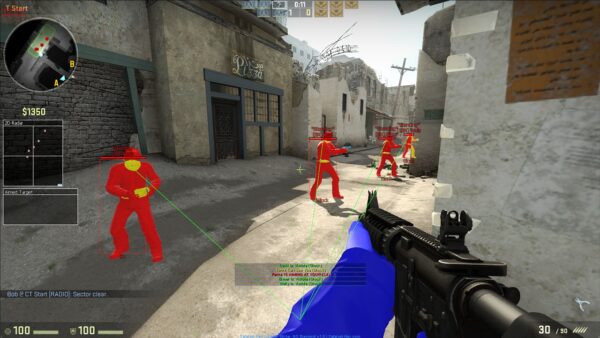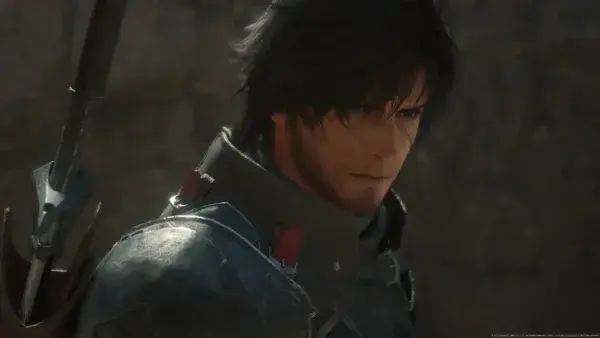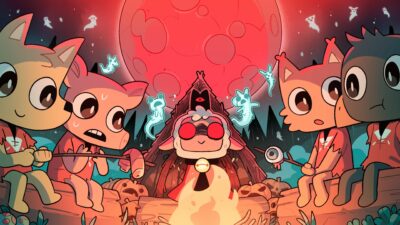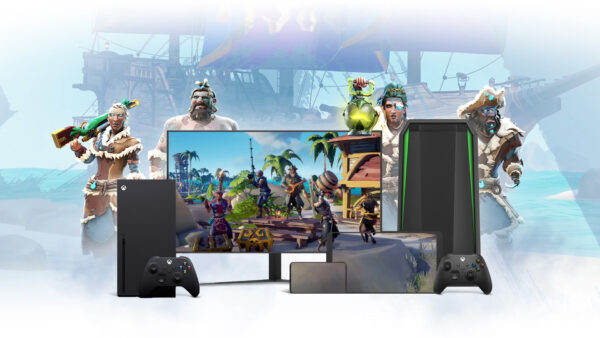
Before Smalland, there was ‘Smalland: the Indiegogo campaign’ – a 2017 effort to crowdfund a survival game about tiny people scratching out an existence in a huge, hostile world. As is often the case with original ideas on crowdfunding platforms, though, Smalland failed to reach its minimum goal of £36,876. Its concept, however, soon caught the eye of British studio Merge Games. “The project was originally owned by a very small team,” the game’s head of production, Ben Averley, tells us. “They realised there was something about the concept that really engaged people, and it generated a load of interest in the community, but the team was clearly struggling… At the time, it was very much a prototype, but Merge Games had a lot of faith in it.”
One IP acquisition later, and Smalland got a second life at Merge. In the four years since, a team of around seven or so ‘decentralised’ artists and designers – among them a couple of members behind the original Smalland prototype – have been working away at turning those initial ideas into a workable reality. It was a process that, Averley says, required the team to pretty much throw out everything that was built before. “We effectively started from scratch. A lot of the art was in a very different style to the direction we felt the game needed to take. So we dropped all of that, all of the original assets, and we pulled in entirely new assets for everything from the characters to the world dressing… in the background, we updated the engine version a few times.”
Fundamentally, though, Smalland remains true to what was pitched back in 2017: it’s a multiplayer sandbox where you can craft and wield weapons to fend off attacks from wasps the size of Shire horses. You can tame and ride grasshoppers and leap across canyon-sized puddles. There’ll be quests to go on and a story to follow, but you can just as easily spend your time exploring, foraging, and building your base. There are PvP battles, but this is an altogether less competitive, in-your-face kind of survival game.
Over a refreshing cup of tea, then, Averley told us more about Merge’s plans for a very different, more whimsical take on the genre.

NPCs play an important role in Smalland, providing quests and useful detail about its world.
Can you give us an idea of the backstory and lore behind the game?
Sure. You’re a small, sprite-like race of creatures. So they’re not humans that have been shrunk down – they’re these incredibly small humanoid people. We affectionately call them ‘small folk’. I don’t know if that’s going to be their official name, but [that’s what] we call them! The idea is that they’ve lived underground for a long time in the darkness, sustaining themselves on the roots of trees and fungi and whatever they could find. Something’s happened on the surface of the world, and humankind’s no longer present. Nature has started to grow back. And so, the small folk decide to venture out to see whether there’s a new frontier out there on the overworld, to try and claim and expand into. And really, that’s the driving factor behind the game… it’s about forging a home in this entirely new environment.
Is camera positioning pivotal in a game like Smalland, because you’ve got to sell the player on the idea of scale – that you’re a very small character in a huge world. What are the challenges there?
It’s difficult, because we provide both first- and third-person views to the player, so we have to make sure that the scale works in both perspectives. Then we have to consider interiors and exteriors. So we do have to make sure everything reinforces the sense of scale. And that’s generally not so much done through the camera itself – it’s more done through intelligent level design, to make sure there are things on the ground, dressings in the world, to make you feel like you’re very small. Almost everything is taller than the player, and that’s clear from every perspective. So it’s about building a world where it’s designed to almost always be bigger than the player.
That sort of feeds into the creatures and the backgrounds as well. Is there a challenge there, when you’re recreating things that people see all the time in real life?
Yes, there is. That’s a core of building a game with this scale: we want things that are recognisable exclusively through their silhouette. Take something like a can-opener, for instance: it’s a very recognisable silhouette. Everyone knows what a can-opener is, but everyone’s used to seeing it at a scale where it’s in your hand – it’s a very small tool. In Smalland, it’s as large as a two-storey house, so we have to think about the intricacies of showing off the mechanics differently. You might not think about the detailing on the handle and the way that the metal flattens and twists in places. So we have to emphasise all of those things to say there is something here you’ve not noticed before in something that you see every day.

Arachnophobes may want to take a deep breath before playing Smalland. Please don’t make us go in here. Gibber.
The creatures, in particular, are difficult: everyone’s used to seeing spiders, for instance. They’re a mechanically complex creature with their eight legs, and various joints on each leg. And while we do try and stay as true to the real world as possible, you do have to gamify how it works a bit. If a spider in the game behaved exactly like a spider in the real world, it would run a thousand miles an hour, grab things and furiously wrap them up in half a second, which wouldn’t make for a very fun experience as a player. So we’ve had to take some license in translating what’s real, particularly in the creature animations, and what can work as a gameplay experience that people will enjoy. Animation itself is very tricky because we’re working from real-world reference, and we’re having to, in this gamification process, reimagine how things might move. So the animations are particularly difficult.
What variety of creatures are there in the game? Do you have a vague number of how many different insects and other life forms there are?
There’ll be approximately a dozen different species of creatures around the Early Access launch. The numbers are still to be confirmed because we’re constantly pushing to try and add as much content and richness to the world as possible. And we do have plans through the Early Access development cycle up to the 1.0 for launch to add many more creatures as we continue to expand the world.
We have a lot of creatures, though: the grasshopper and the ladybird. We have several varieties of spider. We also have fireflies, butterflies, moths, several varieties of beetle, a lizard, dragonflies, and damselflies. Those are the key creatures you interact with at this stage in development. And we have others in the works, but they’re not quite ready to be shared yet.
The systems in the game sound interesting – how they all interlock. But is there a food chain as such? Might you see, say, a spider eat a small insect?
Yes, yes. The world’s built to mimic many of those natural behaviours. We have a complex network of how these creatures will interact. Should they have the opportunity to meet one another in the environment, everything’s on a scale, whether it’s a prey creature all the way down the bottom or an apex creature all the way at the top. Something like a large spider is an apex, so if a spider meets anything – including some other spiders – it may well attack them on sight. But then a ladybird doesn’t predate anything in the world, so it’s at the bottom end of that scale. And then we do creature-to-creature interactions where, for instance, wasps and bees have a very specific relationship in nature.

There are reminders here and there that the landscape you roam once belonged to full-sized humans. Here’s a not-so-subtle one.
With taming certain creatures, how much detail is there in terms of what you can do?
Roughly half a dozen creatures will be tameable at launch, and the majority of those will be rideable as well. There are a few different benefits to taming creatures. Some may fight alongside you when you’re attacked by something, so they act as a kind of territorial pet. Others could be used to bring you resources, but that’s still something we’re working on in secret. Creatures that can be mounted can obviously be ridden around the world – we have a variety of these creatures and they can move in different ways. Grasshoppers can allow you to bound over great ravines, which are just cracks in the ground to us. Dragonflies allow you to hover over a body of water that you otherwise can’t swim through, because you’re incapable of swimming at this point.
So in terms of the survival genre, do you imagine Smalland as being a relatively welcoming game or on the more harsh end of the spectrum?
Relative to a lot of other competitors in the survival genre, we’re trying to stay true to the original vision of the game, which is that it’s quite whimsical. To put it relative to a game such as ARK or Rust, it’s far less competitive. It’s more about being collaborative with players, so we don’t have that combative player-versus-player nature as a major focus. The challenge is almost as much as you want it to be – players can seek out the challenge. It shouldn’t be consistently overbearing and too difficult. It’s not like starting in ARK and having your entire base destroyed by a T-rex in the first five minutes; we want it to be a bit more accommodating and accessible to players. But there’s certainly challenge there, and there’s certainly threats present throughout the world. It’s at the lower end of the spectrum, though, I’d say, relative to other survival games.
So what’s the key to designing an interesting open world – one that isn’t just big, but worth exploring?
As far as creating a working, successful, engaging open-world survival game, obviously, the scale itself is hopefully something that’s quite unique as an offering to Smalland, and will encourage people to explore the world. But beyond that, we have a narrative, so we have quest systems that drive players into different areas to explore. We have resources that vary by area, which, in turn, allow different crafting opportunities for gear, weapons, and bases. So we have player progression gated behind the need to explore these things, and hopefully each brings a new point of interest.

If you’ve ever fantasised about defeating a giant bug in mortal combat, Smalland’s your game.
How much work’s gone into the combat? Is that a system that’s taken a lot of time to refine?
It’s an ongoing battle, refining the combat, and the majority of focus has been an effort to improve and refine the player to creature experiences, but it’s been built with PvP in mind as well. It’s tricky to get right. You move slightly differently because of your scale, you’re a bit lighter because of your strength to bodyweight ratio. It’s a little bit strange when you get into the undergrowth of the world, so we have had to make a couple of adaptations there, but we do have melee and ranged combat, both of which we’ve been honing for PvE.
We’ve had to build our own animation sets. We’ve got a lot of unique rules to abide by, particularly with so many different types of creatures – some that are up to your waist, and some that are five times bigger than you. And that’s been a particular challenge that we’ve had to deal with and make look good, whether you’re using the same sword swing on something that’s half your size or something five times your size. We’d been overcoming that mostly through clever use of animation and really tight bounding on collision for combat.
At the moment, PvP is optional. When you create a server or you join a server, you can have PvP enabled or disabled. We want the game to be collaborative, and we don’t want players to accidentally shoot one another in the back of the head with a bow and arrow. But we do also want to open up the opportunity to make it accessible to players and give them the opportunity to engage in PvP, which we know is an important part of the survival genre for a lot of players. So you’ll be able to invite random people in and you can have a little brawl. We don’t have any encouragement right now for you to engage in PvP, it’s just a bit of fun. Again, it’s not like Rust, where you do base raids to steal a load of someone else’s items and resources. It’s really just about who’s better in the moment, but we do have plans through Early Access to expand on the PvP.
What’s been the biggest challenge so far, would you say?
The biggest challenge has probably been in realising something so unique. We’ve gone through a lot of design iterations to try and craft this experience almost from scratch. As I said, a lot of what was seen early on was quite staged, so there was very little there to work with. We had to go from something that hadn’t been developed but had all these visuals and ideas, then we had to find a way to technically create that and to make it possible.

Some creatures you’ll encounter in Smalland will put up a boss-battle level fight.
There are some things that are just way outside the realms of possibility. And there are a lot of things that we could achieve and we’ve done our best to achieve as many of those as we can to stay true to the Kickstarter and the community, but the design aspect has been massive. The game almost sits somewhere between a single-player RPG experience and an MMO. And it tries to tackle a lot of things – the design is an incredible network of ideas that all relate to one another, that have to be carefully considered. One change in any area could impact 150 other small mechanical parts of the game. So that’s probably been the biggest challenge – just the pure scope of the project.
Smalland’s been in development for a long time, and in the interim, Grounded came out. So how is Smalland different from Obsidian’s game?
Grounded feels much more like a quite fixed RPG-type experience, and less in the survival space. It does have similar elements, and we’d never deny that when they announced Grounded over at Obsidian, it was very much a surprise. But we’ll always welcome that kind of competition and to have more games like that in the market. It’s fantastic. But really, you know, they’ve got this quite fixed, linear experience based around the robot that guides you through the narrative; it’s one to four players, and it’s very much made to be an RPG. They have more of a focus on quite a limited pool of crafting… I don’t want to bash it, but it’s relatively confined; it’s an RPG in a somewhat survival space.
I’d say Smalland’s world is larger, and will continue to expand as well. They’ve built their game to have very strict confines as to progression and where you can explore, and very linear paths. We want our world to be a sandbox, with as much opportunity and freedom for the player to choose how they explore and how they engage with it as they can. We’re also probably a bit more true to the survival genre, and offer a bit more of an organic simulation as well, in the way that our creatures and our world interact with the player.
So finally, what’s left to do before Early Access?
We’re doing a lot of closed testing. We have our Merge Games test group, which people can sign up to.

Smalland has all the base-building you’d expect to see in a survival game. The difference here is that your bases are the size of thimbles.
We’re doing various tests at the moment. I can say what it’s about: it’s a prototype for a set of movement changes to creatures as well as a prototype for a new player. Then there’s equipment that gives you different types of movement – we have a couple of different types of grapple to allow you to swing [Indiana Jones-style] across things, or there’s a new one which allows you to propel yourself forward on, like, a bungee grapple. So we’re continuing to refine a couple of these movement aspects as we finish up the world creation and wrapping up some of that story we talked about, while leaving it open to continue developing during Early Access.
We’re adding a couple of extra creatures in the background – I can’t say which ones yet – and continuing to just refine and polish all of the experiences in the game dressing.
There’s a lot of balancing – boring stuff that people probably won’t be interested in, but balancing all of the values of the health, the damage, the resistance, all of these things.
That’s really a big bulk of work. We’re just continuing to add as much content as possible: building pieces, additional resources, additional things to craft, and things to do. That’s really what we’re working on.





